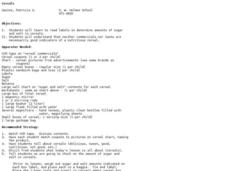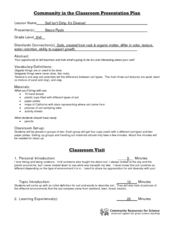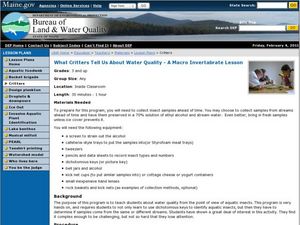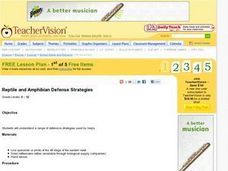Curated OER
Owl Pellets
Sixth graders investigate the role of owls in their ecosystem. In this food chain lesson plan, 6th graders illustrate an owl food chain, dissect an owl pellet, and analyze data. Students discuss what would happen to owls if there were an...
Curated OER
Insect Inquiries
Learners explore the topic of insects. In this biology lesson plan, students develop a curiosity about the insect world. Learners will collect and observe insects native to the area.
Curated OER
Cereals
Students watch television commercials, then analyze the nutritional value of the cereals. In this health and nutrition lesson, the teacher shows students several cereal commercials, then the students describe the cereals. Students read...
Curated OER
Life in a Forest Stream
Students assess macro-invertebrates from a stream. In this science lesson plan, students observe, classify and identify organisms found in a stream. A lab station is constructed at the stream sight and students study the different...
Curated OER
Too Bee Or Not To Bee
Students recognize that bees are important in the reproduction of plants and to the survival of animals. In this bee lesson plan, students become familiar with the parts of bees and how those adaptations help them pollinate plants....
Curated OER
Death On Board La Belle: Finding Clues from Old Bones
Students practice analyzing skeletal remains for clues by using the Internet. In this scientific investigation lesson, students research the La Belle shipwreck using the Internet and written materials, later completing a Skeletal Report...
Curated OER
Kingdom on Fungi
Students explore various types and characteristics of fungi. In this fungi lesson,students view drawings of how mushrooms grow, examine samples of fungi and complete a handout.
Curated OER
Seed Types
Students dissect seeds. In this seed dissection instructional activity, students discover the anatomy of seeds. After dissecting seeds, students hypothesize and design the perfect seed to survive in a dry forest.
Curated OER
My Science Box: Snail Variation
Students observe snails and their characteristics. In this science lesson, students decide how to measure their snails and to observe a behavioral trait. Students create a graph to present their findings.
Curated OER
Soil Isn't Dirty; It's Diverse!
Second graders participate in a soil activity. In this soil lesson students complete a worksheet describing different soil types and the organic and inorganic things found in them.
Curated OER
Electromagnetic Energy and Its Spectrum
Your older elementary learners investigate electromagnetic energy and the electromagnetic spectrum. They will observe 7 items represented in the electromagnetic spectrum and make a poster of all the things the items have in common. After...
Cornell University
Forensic Science: Case of the Missing Diamond Maker
Someone stole a diamond-making machine. Who done it? Scholars use forensic science at six different stations to determine the culprit. They analyze fingerprints, use their senses, and complete chemistry experiments to determine the...
Curated OER
The Microscope and Cell
In this science worksheet, students calculate the size of different samples using the microscope as part of a formal lab assignment.
Science Friday
Ugh, a Bug!
Young entomologists familiarize themselves with the physical characteristics of insects. Composed of two activities, each instructional activity involves your scientists tapping into their prior knowledge of bugs and making observations...
Curated OER
All in the (Insect) Family
Students participate in a series of activities in order to explore the diversity of insects. They explore how insects are grouped and categorized.
Curated OER
Totally Termites
Students explore the world of termites, their adaptations, and anatomy. They examine the property risks of termites and how pest control professionals manage termite problems.
Curated OER
Critters in the Classroom
Students investigate with sea urchins. In this ocean habitat lesson, students observe sea urchins and other ocean grazers. Students work with lab equipment to examine the anatomy of these creatures.
Curated OER
Geometry: Practical Applications of the Distance Formula
Students, working independently and in groups, apply the distance formula to practical situations. After solving various problems, students in pairs design coordinate planes from the school blue print to measure the distance from the...
Curated OER
Respect the Beach
Students work together to compare and contrast sand particles. They identify what sand grains are composed of as well. They complete writing activities to complete the lesson.
Curated OER
King Cotton
Sixth graders investigate the farming process for cotton and its impact on the United States history. In this cotton farming lesson, 6th graders read background information on the cotton farming process and discuss the role of slavery in...
Curated OER
What Critters Tell Us About Water Quality: A Macroinvertebrate Lesson
Students explore our ecosystem by investigating the quality of our water. In this aquatic insect lesson, students examine a group of random insects collected from different streams and ponds in the area. Students record their...
Curated OER
Science of Money
Students observe oxidation reaction in the lab using copper pennies. For this chemistry lesson, students examine a $1 dollar bill and record their observations. They explain how to identify counterfeit money using the iodine test.
Curated OER
Does the Introduction of Pesticides and Fertilizers Alter an Aquatic Ecosystem?
Students conduct an experiment using a small sample from a local water source. They introduce fertilizers and pesticides, separately, and carefully examine the results in their simulated aquatic ecosystem.
Curated OER
Reptile and Amphibian Defense Strategies
Students study the stages of the Eastern newt either by collecting a live specimen or from pictures. They note the colors of the eft stage before reading the "Eastern Newt Species Account" that shows the newt's life stages, migration,...

























